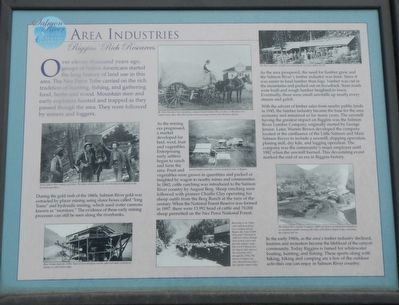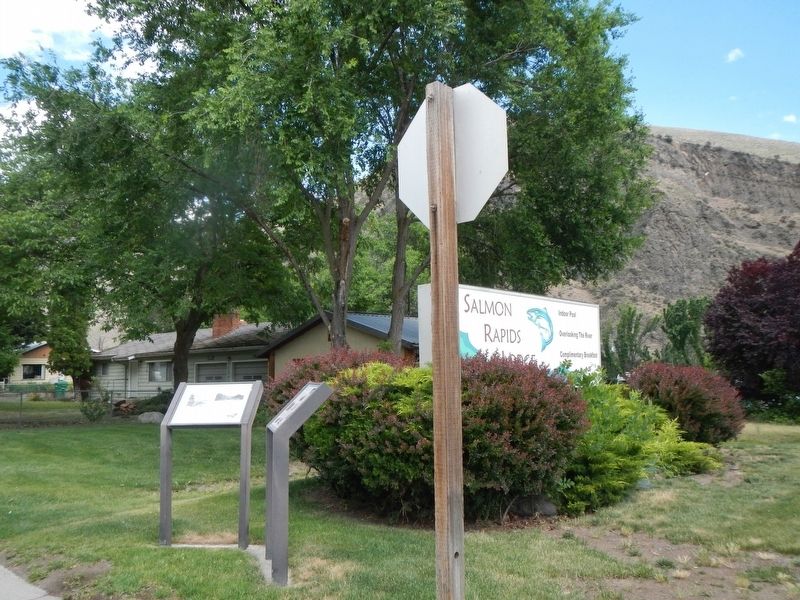Riggins in Idaho County, Idaho — The American West (Mountains)
Area Industries
Riggins’ Rich Resources
— Salmon River Heritage Waking Tour —

Photographed By Barry Swackhamer, May 4, 2018
1. Area Industries Marker
Captions: (center left) Early Salmon River mining operation. The mule carried an ore care over 60 miles from McCall to the Good Enough Mine.l (bottom left) River dredge from the 1930s. Signs of river dredging and the adits and shafts of hardrock mining are still visible today.; (upper center) By 1916, Herschel Clay's freighting company hauled Salmon River produce to Meadows on a regular basis. Here, Herschel and his team are posing in front of the Meadows School.; (center) Load of lumber from Race Creek sawmill en route to Riggins.; (bottom center) Beginning in the 1920s, cattle and sheep drives were a unique part of Riggins life. Some 25,000 sheep and 7,000 head of cattle were driven through town on their way to and from the summer range. The Circle C Ranch was the largest cattle ranch in the area from 1925 through the 1970s. The livestock industry has since dwindled and only a few ranches remain today.; (top right) The Pipes and Clay sawmill was located up the west fork of Race Creek.; (lower right) The Salmon River Lumber Company. Additional historical information and photos are available for public viewing in the lobby of the Salmon Rapids Lodge overlooking the original mill site.
During the gold rush of the 1860s, Salmon River gold was extracted by placer mining using sluice boxes called “long Toms” and hydraulic mining, which used water cannons known as “monitors.” The evidence of these early mining processes can still be seen along the riverbanks. br As the mining era progressed, a market developed for beef, wool, fruit and vegetables. Enterprising early settlers began to ranch and farm the area. Fruit and vegetables were grown in quantities and packed or freighted by wagon to nearby mines and communities. In 1863, cattle ranching was introduced to the Salmon River country by August Berg. Sheep ranching soon followed with pioneer Charlie Clay operating his sheep outfit from the Berg Ranch at the turn of the century. When the National Forest reserve was formed in 1897, there were 13,992 head of cattle and 70,000 sheep permitted on the Nez Perce National Forest.
As the area prospered, the need for lumber grew and the Salmon River’s timber industry was born. Since it was easier to haul lumber than logs, lumber was cut in the mountains and packed out on horseback. Soon roads were built and rough lumber freighted to town. Eventually, there were small sawmills up nearly every stream and gulch.
With the advent of timber sales from nearby public lands in 1945, the lumber industry became the base for the area economy and remained so for many years. The sawmill having the greatest impact on Riggins was the Salmon River Lumber Company originally started by George Jensen. Later, Warren Brown developed the company located at the confluence of the Little Salmon and Main Salmon Rivers to include a sawmill, shipping operation, planing mill, dry kiln, and logging operation. The company was the community’s major employer until 1982 when the sawmill burned. This devastating event marked the end of an era in Riggins history.
In the early 1980s, as the area’s timber industry declined, tourism and recreation became the lifeblood of the canyon community. Today Riggins is famed for whitewater boating, hunting, and fishing, These sports along with hiking, biking and camping are a few of the outdoor activities one can enjoy in Salmon River country.
Erected by City of Riggins.
Topics. This historical marker is listed in this topic list: Industry & Commerce. A significant historical year for this entry is 1863.
Location. 45° 25.044′ N, 116° 19.074′ W. Marker is in Riggins, Idaho, in Idaho County. Marker is on Main Street (U.S. 95) near Well Street, on the right when traveling north. Touch for map. Marker is at or near this postal address: 1015 Main Street, Riggins ID 83549, United States of America. Touch for directions.
Other nearby markers. At least 8 other markers are within walking distance of this marker. More Valuable Than Gold (a few steps from this marker); Memorable Homes (approx. 0.2 miles away); You’ve Got Mail (approx. 0.2 miles away); Gouge-Eye Legend (approx. 0.2 miles away); The Forest Service (approx. ¼ mile away); Clay's Swinging Bridge (approx. ¼ mile away); Riggins' Early Hotels (approx. 0.3 miles away); Riggins in the 1940s (approx. 0.3 miles away). Touch for a list and map of all markers in Riggins.
Credits. This page was last revised on June 27, 2018. It was originally submitted on June 27, 2018, by Barry Swackhamer of Brentwood, California. This page has been viewed 136 times since then and 13 times this year. Photos: 1, 2. submitted on June 27, 2018, by Barry Swackhamer of Brentwood, California.
